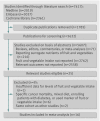Fruit and vegetable consumption and mortality from all causes, cardiovascular disease, and cancer: systematic review and dose-response meta-analysis of prospective cohort studies
- PMID: 25073782
- PMCID: PMC4115152
- DOI: 10.1136/bmj.g4490
Fruit and vegetable consumption and mortality from all causes, cardiovascular disease, and cancer: systematic review and dose-response meta-analysis of prospective cohort studies
Erratum in
- BMJ. 2014;349:5472
Abstract
Objective: To examine and quantify the potential dose-response relation between fruit and vegetable consumption and risk of all cause, cardiovascular, and cancer mortality.
Data sources: Medline, Embase, and the Cochrane library searched up to 30 August 2013 without language restrictions. Reference lists of retrieved articles.
Study selection: Prospective cohort studies that reported risk estimates for all cause, cardiovascular, and cancer mortality by levels of fruit and vegetable consumption.
Data synthesis: Random effects models were used to calculate pooled hazard ratios and 95% confidence intervals and to incorporate variation between studies. The linear and non-linear dose-response relations were evaluated with data from categories of fruit and vegetable consumption in each study.
Results: Sixteen prospective cohort studies were eligible in this meta-analysis. During follow-up periods ranging from 4.6 to 26 years there were 56,423 deaths (11,512 from cardiovascular disease and 16,817 from cancer) among 833,234 participants. Higher consumption of fruit and vegetables was significantly associated with a lower risk of all cause mortality. Pooled hazard ratios of all cause mortality were 0.95 (95% confidence interval 0.92 to 0.98) for an increment of one serving a day of fruit and vegetables (P=0.001), 0.94 (0.90 to 0.98) for fruit (P=0.002), and 0.95 (0.92 to 0.99) for vegetables (P=0.006). There was a threshold around five servings of fruit and vegetables a day, after which the risk of all cause mortality did not reduce further. A significant inverse association was observed for cardiovascular mortality (hazard ratio for each additional serving a day of fruit and vegetables 0.96, 95% confidence interval 0.92 to 0.99), while higher consumption of fruit and vegetables was not appreciably associated with risk of cancer mortality.
Conclusions: This meta-analysis provides further evidence that a higher consumption of fruit and vegetables is associated with a lower risk of all cause mortality, particularly cardiovascular mortality.
© Wang et al 2014.
Conflict of interest statement
Competing interests: All authors have completed the ICMJE uniform disclosure form at
Figures





Comment in
-
Fruit and vegetable consumption is associated with reduced all-cause and cardiovascular mortality.Evid Based Med. 2015 Feb;20(1):14. doi: 10.1136/ebmed-2014-110092. Epub 2014 Oct 24. Evid Based Med. 2015. PMID: 25344249 No abstract available.
References
-
- Joint WHO/FAO Expert Consultation. Diet, nutrition and the prevention of chronic diseases. World Health Organ Tech Rep Ser 2003;916:1-149. - PubMed
-
- National Academy of Sciences CoDaH, National Research Council. Diet and health: implications for reducing chronic disease risk. National Academy Press, 1989. - PubMed
-
- World Health Organization. The top 10 causes of death. WHO,2012. www.who.int/mediacentre/factsheets/fs310/en.
-
- Agudo A, Cabrera L, Amiano P, Ardanaz E, Barricarte A, Berenguer T, et al. Fruit and vegetable intakes, dietary antioxidant nutrients, and total mortality in Spanish adults: findings from the Spanish cohort of the European Prospective Investigation into Cancer and Nutrition (EPIC-Spain). Am J Clin Nutr 2007;85:1634-42. - PubMed
Publication types
MeSH terms
Grants and funding
LinkOut - more resources
Full Text Sources
Other Literature Sources
